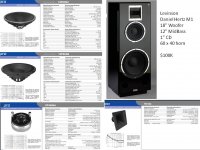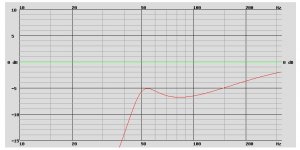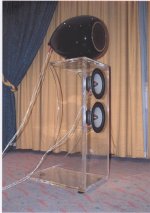I bought recently a pair of Beyma 12p80nd, and combine it with Beyma TPL150. Crossover from Beyma, model 212, crossing at 1,2khz.
I use the midwoofer in a cabinet with a port on the back side, cabinet size 40cm x 40cm, x 90cm. Based on information from a site in norway, i was expecting specially excellent lower midrange.
But these excell as well as woofers. I have not much lower bass output, i guess below 50,60hz , they go out of steam, but what a performance in the range they cover. Just amazing !! They outperform by far my expectations. Very clean, strong bass, correct timbre and neutrality , transients to die for, these are really really great fun !!
They make for a very satifying 2way monitor for highest demands.
Maibe someone can help me to calculate the size of a ported cab, to have a littlebit more lower bass output. If they would go strong down to 40hz, that would be great.
Angelo
I use the midwoofer in a cabinet with a port on the back side, cabinet size 40cm x 40cm, x 90cm. Based on information from a site in norway, i was expecting specially excellent lower midrange.
HiFiForum.nu - Beyma TPL-150H ihop med vadå...?
Petty speaks wise words. , I would say 12P80Nd (note not "Fe"!). they are wonderfully efficient and ultra dynamic elements. I've never heard anything like in the case of transients and "cut" in the sound. Nd-magnets have a much greater magnetic stability, and in the case 12P80Nd so is their pole pieces very well saturated and very stable and resistant to eddy-currents on stuff . Due to its ultra-strong magnetic system will answer them very nicely on the current drive, which probably can get them than a little djeafligare in terms of impulse response and dynamics. They sound also very neutral (to be effective) and correct. They are unique elements simply. Regards John.
Beyma Tpl-150 - Page 5 - Audio Voice Acoustics
I have had time to play around with the new 12orna, . They are not even an iota of recorded yet, does not go nearly as deep as the 12P1000Ndsom sat in the same boxes two days ago. But what comes out! This is the most transient I've ever heard, with a resolution and with a tone that is purely amazing, I have not even heard a field coil element with the poise and sense of effortless at the base and the naturalness of voices and foundations in guitars and so on. I definitely think that anyone thinking of a little more TH or maybe kvartsvågspipor, or perhaps real horns, should include these elements in their thoughts. Then they can man be the foundation for a new model, a "supermoc" perhaps? TPL treble in originalmocarna included waveguide now, which enhance the sensitivity of 102dB, we need, then just find a nice 24 "or maybe 30" to the bottom? Ingvar
Cord Children: Yes, it's a horrible fear of driving to work in the morning. Mathias! After a few days of listening, I think: the resolution, just like the version without the horns, incredible, välinspelade strings and percussion is ridiculous live and recordings that feels a little loud will be nicer then the element is completely free from ringing. Really bad recordings are however quite olyssningsbara when the treble is extremely revealing. Some boards feel a little # 8221, call # 8221; in the sound, probably due to the extremely low distortion, a compression driver is of course much higher 1st and 2nd harmonic distortion which adds some warmth and softness that are typically very pleasant to listen to. The combination QW-1 and the treble is really fun to listen to, now, are both basses to be recorded as well and they perform an amazing base and an addictive intimacy and life of the votes. Mathias: I have not really the plant, mocarna was too small, sometimes you could not find them if no music was played, it thus becomes larger versions, but there are advanced plans for a baby sister, mlk, (go ahead and guess! ) Hornta! Crossover 1200-1300, 2nd order LR, schedule is on PM, forgot to answer yours. Ingvar
But these excell as well as woofers. I have not much lower bass output, i guess below 50,60hz , they go out of steam, but what a performance in the range they cover. Just amazing !! They outperform by far my expectations. Very clean, strong bass, correct timbre and neutrality , transients to die for, these are really really great fun !!
They make for a very satifying 2way monitor for highest demands.
Maibe someone can help me to calculate the size of a ported cab, to have a littlebit more lower bass output. If they would go strong down to 40hz, that would be great.
Angelo
Last edited:
Beyma 12P80Nd
Good in a 4-10L BR enclosure (6.4 L 90_Hz tunning).
More details for different applications Martinsson's Blog - THAM12
Good in a 4-10L BR enclosure (6.4 L 90_Hz tunning).
More details for different applications Martinsson's Blog - THAM12
Angelo,
Consider using the 12p80nd with its Qtc=0.15 as a true midbass in a sealed well stuffed enclosure, and adding a large efficient woofer at 80-100Hz. This type of 3-way would optimize the midbass(sealed) while minimizing Dopler type IMD from mixing 1.2Khz with any bass cone movement. Mark Levinson uses the 12p80nd with the similar constructed Beyma 18p80nd in his Daniel Hertz M1 $100K speaker. Using your TPL 150H 80 x 30 horn HEIL would deliver good controlled directivity over the 1200Hz Xover range to the 12P80nd.
Large radius cabinet edges that minimize diffraction would allow you to beat the $100K M1 sonics.
Consider using the 12p80nd with its Qtc=0.15 as a true midbass in a sealed well stuffed enclosure, and adding a large efficient woofer at 80-100Hz. This type of 3-way would optimize the midbass(sealed) while minimizing Dopler type IMD from mixing 1.2Khz with any bass cone movement. Mark Levinson uses the 12p80nd with the similar constructed Beyma 18p80nd in his Daniel Hertz M1 $100K speaker. Using your TPL 150H 80 x 30 horn HEIL would deliver good controlled directivity over the 1200Hz Xover range to the 12P80nd.
Large radius cabinet edges that minimize diffraction would allow you to beat the $100K M1 sonics.
Attachments
Angelo,
Consider using the 12p80nd with its Qtc=0.15 as a true midbass in a sealed well stuffed enclosure, and adding a large efficient woofer at 80-100Hz. This type of 3-way would optimize the midbass(sealed) while minimizing Dopler type IMD from mixing 1.2Khz with any bass cone movement. Mark Levinson uses the 12p80nd with the similar constructed Beyma 18p80nd in his Daniel Hertz M1 $100K speaker. Using your TPL 150H 80 x 30 horn HEIL would deliver good controlled directivity over the 1200Hz Xover range to the 12P80nd.
Large radius cabinet edges that minimize diffraction would allow you to beat the $100K M1 sonics.
Interesting. I am thinking to make a small production for local commerce, there is a small audioshop in town, which sells Wilson Watt Puppys for us$ 35k a pair, used.....so i think i will have some space there to show mine. But size is a issue. I want to keep the speakers slim. Maibe using a sub on the side rather than on the front panel would help. Maibe a backloaded horn would help getting more bass output, without sub needed ?
I do not believe you can get a great sounding slim speaker if you start with a 12" midbass.
For the best sound a midrange needs several inches of space with fiberglass on all sides to absorb the rear cone wave. Hence, a 12" midbass favors a 16" - 18" wide cabinet. The woofer can be located much closer to the cabinet side walls with little sonic loss if the cabinet is well braced. The M1 cabinet uses this spacing ... air around the midbass, woofer frame against the sides. Baffle step compensation of a 20" wide cabinet is ~250Hz, and the woofer floor gain can sometimes get height adjusted to reduce BSC for "in-room" placement.
The Levinson Daniel Hertz M1 has many positive reviews and BUZZ. A M1 clone with the TPL150H for say US$ $15K/pair should draw significant interest. The audio world would be very interested in comparing a M1 type cabinet with the TPL150H tweeter vs. the real $100K Daniel Hertz with CP385Nd CD and TD164 horn. Daniel Hertz M1 H=60" W=22" D=18.5"
For the best sound a midrange needs several inches of space with fiberglass on all sides to absorb the rear cone wave. Hence, a 12" midbass favors a 16" - 18" wide cabinet. The woofer can be located much closer to the cabinet side walls with little sonic loss if the cabinet is well braced. The M1 cabinet uses this spacing ... air around the midbass, woofer frame against the sides. Baffle step compensation of a 20" wide cabinet is ~250Hz, and the woofer floor gain can sometimes get height adjusted to reduce BSC for "in-room" placement.
The Levinson Daniel Hertz M1 has many positive reviews and BUZZ. A M1 clone with the TPL150H for say US$ $15K/pair should draw significant interest. The audio world would be very interested in comparing a M1 type cabinet with the TPL150H tweeter vs. the real $100K Daniel Hertz with CP385Nd CD and TD164 horn. Daniel Hertz M1 H=60" W=22" D=18.5"
I do not believe you can get a great sounding slim speaker if you start with a 12" midbass.
For the best sound a midrange needs several inches of space with fiberglass on all sides to absorb the rear cone wave. Hence, a 12" midbass favors a 16" - 18" wide cabinet. The woofer can be located much closer to the cabinet side walls with little sonic loss if the cabinet is well braced. The M1 cabinet uses this spacing ... air around the midbass, woofer frame against the sides. Baffle step compensation of a 20" wide cabinet is ~250Hz, and the woofer floor gain can sometimes get height adjusted to reduce BSC for "in-room" placement.
The Levinson Daniel Hertz M1 has many positive reviews and BUZZ. A M1 clone with the TPL150H for say US$ $15K/pair should draw significant interest. The audio world would be very interested in comparing a M1 type cabinet with the TPL150H tweeter vs. the real $100K Daniel Hertz with CP385Nd CD and TD164 horn. Daniel Hertz M1 H=60" W=22" D=18.5"
I have not heard the Beyma CP385Nd CD and TD164 horn, but based on all Beyma speakers i have heard, i can imagine these sound excellent. But i can hardly imagine any compression driver, even from Beyma, can come close to the performance of the TPL150. I didnt know the Daniel Hertz M1 uses the 12p80nd. Based on the performance of this midwoofer, i fully understand the positive reviews. I am not interested in cloning anyone, but want to develop something of my own. I do not want to add a woofer, but get as much extension of the 12p80nd as possible. I want to keep it two ways, and rather small sized, for small rooms. Maibe a 60l bass reflex, with the ports on the backside, would be a good solution ? or a BL horn ? And i want the TPL150 bipole. Sounds better, moro holographic and 3d to me.
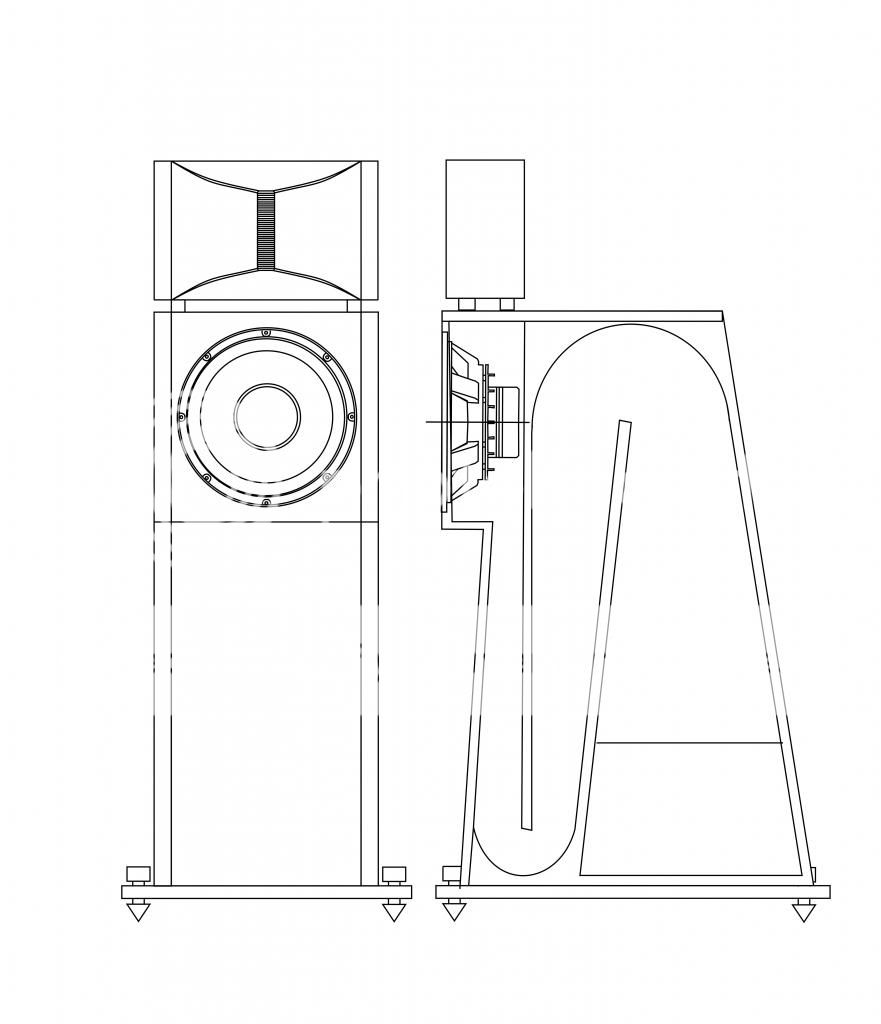
Last edited:
For all that was said, that's not a good solution. (look @graph below)...Maibe a 60l bass reflex, with the ports on the backside, would be a good solution ?
LineSource, I agree about the concept and like very much the pics/loudspeaker, also I very much appreciate the ingenuity of Angelo.
Attachments
Large radius cabinet edges that minimize diffraction would allow you to beat the $100K M1 sonics.
Do you think the edge shape would have that kind of influence ?
Like something like this ?
Triad Cinema Reference CR-1 Loudspeaker Preview

I have a fair deal of experience with Beyma TPL150 and TPL150H. I much prefer TPL150H with the waveguide over the standard TPL150.
1.2 kHz is too low XO for both of them if you seek ultimate performance. In my opinion 1.5 to 2 kHz is more appropriate.
Also - both drivers benefit from removing the rear chamber and felt damping pad, and let the rear side exit into a large damped chamber. THD is reduced by almost 20 dB by doing this.
1.2 kHz is too low XO for both of them if you seek ultimate performance. In my opinion 1.5 to 2 kHz is more appropriate.
Also - both drivers benefit from removing the rear chamber and felt damping pad, and let the rear side exit into a large damped chamber. THD is reduced by almost 20 dB by doing this.
Last edited:
TPL needs 3 way or line array?
Hi Angelo,
I agree with StigErik ( only fools disagree!),
Use the Beyma horn (or the Autotech Polish horn) for the TPL, crossover at 1.8KHz or there abouts, any lower and it sounds a bit stressed.
This sadly eliminates a 12 inch mid bass as it will beam too much up high.
You could use an 8 inch (PHL are great) or at the most a 10 inch (Volt or PHL) and then crossover to one or two Beyma bass driver(s)?
As an off the wall ( !) suggestion.... If you really want to stick to a two way with the Beyma 12 inch, how about using four 12 inch drivers Beyma's per speaker, wired for 8 Ohms will give you a 6dB gain in sensitivity, this will be a great match with the horn loaded TPL.
You could have a two piece cabinet, three twelve incher's in the lower section, approx 1 meter high. Then another cabinet with the TPL horn and the last 12 incher above it.
To load the bass / mid...I love open baffle,( see attached pic) if you have the space behind the speakers.
If not, go for sealed and use Eq, avoid ports and back loaded horns like the plague!
Hope this helps!
Cheers
Derek.
Hi Angelo,
I agree with StigErik ( only fools disagree!),
Use the Beyma horn (or the Autotech Polish horn) for the TPL, crossover at 1.8KHz or there abouts, any lower and it sounds a bit stressed.
This sadly eliminates a 12 inch mid bass as it will beam too much up high.
You could use an 8 inch (PHL are great) or at the most a 10 inch (Volt or PHL) and then crossover to one or two Beyma bass driver(s)?
As an off the wall ( !) suggestion.... If you really want to stick to a two way with the Beyma 12 inch, how about using four 12 inch drivers Beyma's per speaker, wired for 8 Ohms will give you a 6dB gain in sensitivity, this will be a great match with the horn loaded TPL.
You could have a two piece cabinet, three twelve incher's in the lower section, approx 1 meter high. Then another cabinet with the TPL horn and the last 12 incher above it.
To load the bass / mid...I love open baffle,( see attached pic) if you have the space behind the speakers.
If not, go for sealed and use Eq, avoid ports and back loaded horns like the plague!
Hope this helps!
Cheers
Derek.
Attachments
Me too.I bought recently a pair of Beyma 12p80nd, and combine it with Beyma TPL150.
I'm not in your league though.
My slow paced, largely experimental build: My 1st HE build (Beyma)
Really great drivers. I will probably ultimately use subwoofer(s) to cover <50Hz.
My lounge has a big dip at 45Hz and peak at about 30Hz. I tuned to 45 Hz so I get sufficient bass down to 30Hz without subwoofer.
Is TPL150H, chamber and felt removed, in large damped enclosure better than TPL150 dipole?I have a fair deal of experience with Beyma TPL150 and TPL150H. I much prefer TPL150H with the waveguide over the standard TPL150.
1.2 kHz is too low XO for both of them if you seek ultimate performance. In my opinion 1.5 to 2 kHz is more appropriate.
Also - both drivers benefit from removing the rear chamber and felt damping pad, and let the rear side exit into a large damped chamber. THD is reduced by almost 20 dB by doing this.
I wonder how much quality we sacrifice by crossing as low as 1.2kHz.
Less of a problem with the TPL150H than the TPL150?
The 12P80Nd + TPL150H seems to be a very nice combination.
Me too.
I'm not in your league though.
My slow paced, largely experimental build: My 1st HE build (Beyma)
Really great drivers. I will probably ultimately use subwoofer(s) to cover <50Hz.
My lounge has a big dip at 45Hz and peak at about 30Hz. I tuned to 45 Hz so I get sufficient bass down to 30Hz without subwoofer.
I am testing and listening the TPL150 now in combination with the 12p80nd without waveguide, and with the back open. But different to previous listening, i am using as power amp a Classé Audio DR3b. The impression i have, is that with some music treble sounds a little harsh, almost agressive. Hard to say to what to attribute it, many factors involved. Maibe its the recording, different amp, wave guide missing... who knows.
My main concern is however to make a cabinet, that permits lower bass extension. A backloaded horn seems to be the way to go......probably i will make a design with the horn mouth on the front side, and the backchamber no.2, as shown here :
http://www.ryboxhorn.de/images/Vorkammertyp01.pdf
Last edited:
What about transmission line or TQWT?
Locally we were contemplating a 2.5way TQWT and I think it is a good option.
Perhaps with an enclosure like this for the two 12P80Nd (TPL in a separate section above):

I'm very inexperienced but the TPL150H, chamber removed in large damped enclosure makes the most sense to me theoretically.
Locally we were contemplating a 2.5way TQWT and I think it is a good option.
Perhaps with an enclosure like this for the two 12P80Nd (TPL in a separate section above):
I'm very inexperienced but the TPL150H, chamber removed in large damped enclosure makes the most sense to me theoretically.
Angelo,
A 30 / 60 /90 polar SPL measurement of your Beyma 12P80Nd could save the world!
I lied. It would just allow owners to better select a Xover frequency.
The Daniel Hertz M1 claims a 18db Xover at 1600 Hz to the 60 x 40 tweeter horn. (1800 hz on first production). A 60 degree tweeter polar pattern horn has evolved from "man cave" wierd to small apartment cool. A 90x40 tweeter polar remains my favorite.
If you build a 1600Hz to 50Hz rear horn I would expect smeared high frequencies from the horn mouth, and dopler IMD from mixing a 1600Hz Flute on a 50Hz bass tone. A stuffed T-iine or MLTL absorbs rear cone highs, but the Qts=0.15 has some challenges.
Low-A on a Grand Piano is 27.5 Hz.
A 30 / 60 /90 polar SPL measurement of your Beyma 12P80Nd could save the world!
I lied. It would just allow owners to better select a Xover frequency.
The Daniel Hertz M1 claims a 18db Xover at 1600 Hz to the 60 x 40 tweeter horn. (1800 hz on first production). A 60 degree tweeter polar pattern horn has evolved from "man cave" wierd to small apartment cool. A 90x40 tweeter polar remains my favorite.
If you build a 1600Hz to 50Hz rear horn I would expect smeared high frequencies from the horn mouth, and dopler IMD from mixing a 1600Hz Flute on a 50Hz bass tone. A stuffed T-iine or MLTL absorbs rear cone highs, but the Qts=0.15 has some challenges.
Low-A on a Grand Piano is 27.5 Hz.
Last edited:
What about transmission line or TQWT?
Locally we were contemplating a 2.5way TQWT and I think it is a good option.
Perhaps with an enclosure like this for the two 12P80Nd (TPL in a separate section above):

I'm very inexperienced but the TPL150H, chamber removed in large damped enclosure makes the most sense to me theoretically.
thats a interesting idea. Simple to build....
can anyone make the math for the 12p80nd ?
This site has some useful info and calculators: mh-audio.nl - Home
Are you quite happy with the Beyma Crossover as it is?
Are you quite happy with the Beyma Crossover as it is?
This site has some useful info and calculators: mh-audio.nl - Home
Are you quite happy with the Beyma Crossover as it is?
hi John
no, i am not happy with the crossover. I suspect it is the reason for the harshness of the TPL-150. Listening right now again with my big system, and there the Beyma sounds sweet and without harshness at all. Crossover point is the same.
Yesterday i made a new experiment. I just replaced the lower midrange horn of my big system, and inserted the 12p80nd. It was that big fun, that i listened music the whole afternoon. Since the efficiency is the same as the TPL150, no Lpad needed. Just amazing, clean, undistored and BIG sound. What is remarkable, is how the position makes such a big difference. Playing as previously almost nearfield, sounds not even close as good, as placing the cabs as they are now. As incredible as it might appear, but the Beyma 12p80nd as is sounds much better than my lower midrange horn. The distortion is amazingly low. Luis Armstrong Live in Chicago sounds scaringly life like, almost as being there.
The core is really the TPL150, with the 12p80nd. Only add a powerful sub, and you are done. Your wildest dreams of high-end audio come true. No kidding !!
Anyone wants to buy my lower midrange horn ?
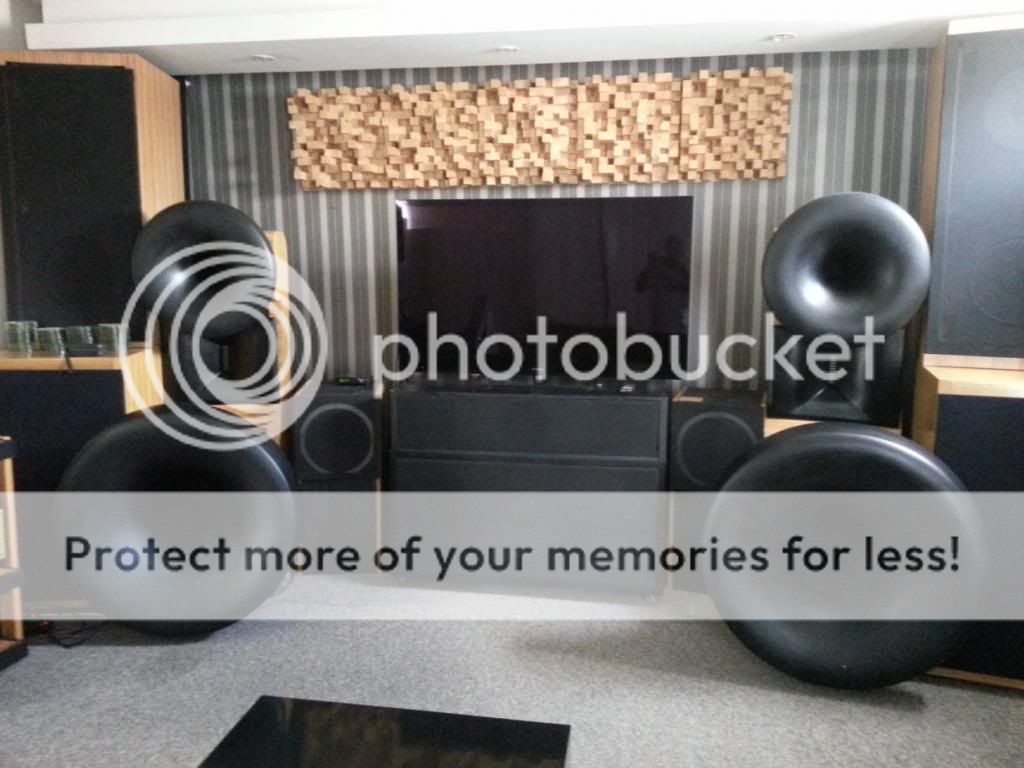
The core is really the TPL150, with the 12p80nd. Only add a powerful sub, and you are done. Your wildest dreams of high-end audio come true. No kidding !!
Anyone wants to buy my lower midrange horn ?

Last edited:
- Home
- Loudspeakers
- Multi-Way
- Beyma 12P80ND + TPL-150
